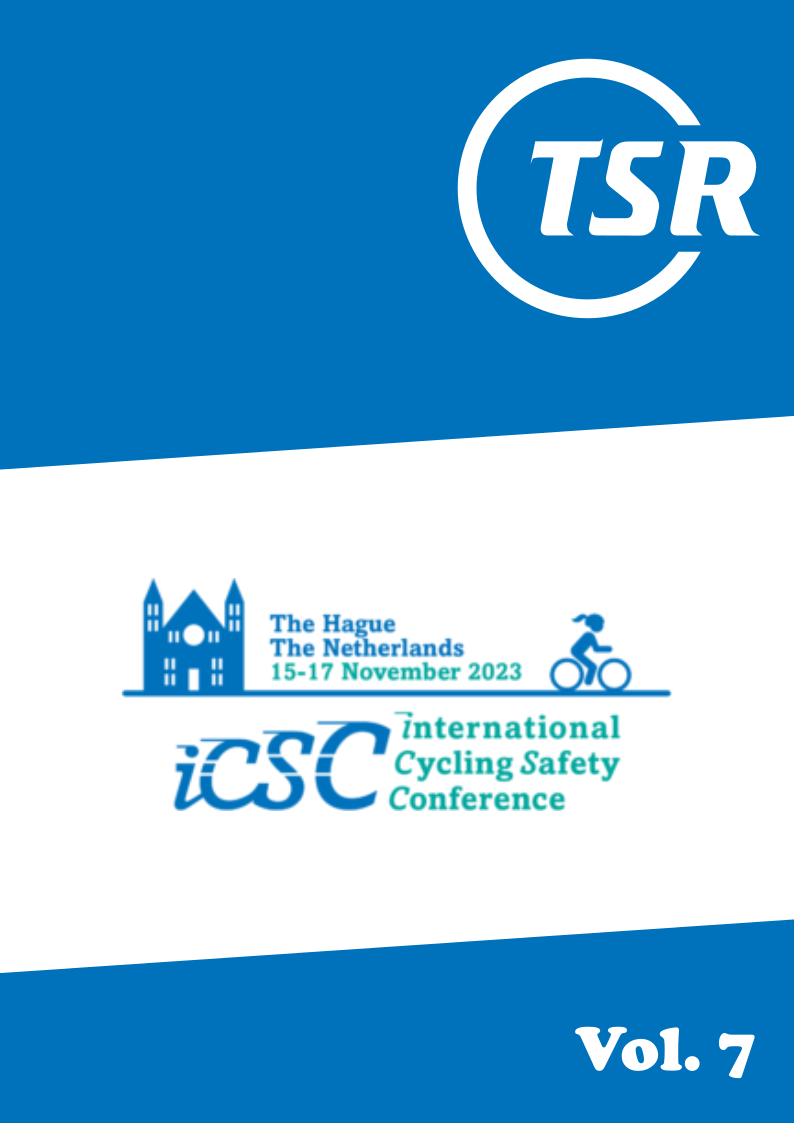Introducing right turn on red for cyclists—a before-after study on behavioural adaption in Germany
DOI:
https://doi.org/10.55329/iehf1403Keywords:
bicycle-bicycle interaction, traffic regulation, pilot study, Behavioural observation, traffic conflictsAbstract
Right Turn On Red (RTOR) for cyclists is a low-cost and easy-to-implement improvement for cycling that is practised in several European countries and has been discussed for implementation in Germany. This study investigates the effects of introducing RTOR for cyclists based on video observations at 43 sites in nine German cities including all relevant types of cycling infrastructure (mixed traffic, cycle lanes, cycle tracks). Using a before-after approach, the study compares cyclist behaviour in terms of compliance with traffic rules and conflicts with other users. Overall, the introduction of RTOR legalised behaviour that had already been practised. The share of cyclists turning right on red, which was already high at 80% before the introduction of RTOR, increased to 93% with RTOR, and cyclists were more likely to comply with traffic rules and less likely to cycle on the pavement. Conflicts were mainly observed between right-turning cyclists and other cyclists as well as pedestrians. The number of conflicts increased after the introduction of RTOR while conflict criticality decreased. Cyclists gave more space to other users and obstructed them less with RTOR in place. The only exception to this were conflicts in the approach, where more close overtaking manoeuvres and wriggling through other users were observed. RTOR should therefore only be recommended if sufficient space is available or cyclists mainly turn right at an intersection. Based on the results of this study, recommendations for RTOR for cyclists have been introduced in the German Highway Code.
Downloads
References
Alrutz, D., W. Bohle, H. Müller, H. Prahlow, U. Hacke, G. Lohmann (2009), 'Unfallrisiko und Regelakzeptanz von Fahrradfahrern [Accident risk and rule acceptance by cyclists]', Bundesanstalt für Straßenwesen, Verkehrstechnik Heft V 184.
Bai, L., N. N. Sze (2020), 'Red light running behavior of bicyclists in urban area: Effects of bicycle type and bicycle group size', Travel Behaviour and Society, 21, 226–234. DOI: https://doi.org/10.1016/j.tbs.2020.07.003
Beitel, D., J. Stipancic, K. Manaugh, L. Miranda-Moreno (2018), 'Assessing safety of shared space using cyclist-pedestrian interactions and automated video conflict analysis', Transportation Research Part D: Transport and Environment, 65, 710–724. DOI: https://doi.org/10.1016/j.trd.2018.10.001
BIVV, (2012), 'Proefproject in het Brussels Hoofdstedelijk Gewest met de toelating voor fietsers om rechtsaf door rood te rijden (B22) of om rechtdoor door rood te rijden (B23): verslag van een voor- en na-evaluatie [Pilot project in the Brussels-capital region allowing cyclists to turn right on red (B22) or to go straight on red (B23)]', Belgisch Instituut voor de Verkeersveiligheid.
Buehler, R., J. Pucher (2021), 'The growing gap in pedestrian and cyclist fatality rates between the United States and the United Kingdom, Germany, Denmark, and the Netherlands, 1990–2018', Transport Reviews, 41(1), 48–72. DOI: https://doi.org/10.1080/01441647.2020.1823521
Certu, (2012), 'Cédez-le-passage cycliste au feu rouge [Give way to cyclists at red lights]', Certu, Fiche N°05.
De Ceunynck, T., S. Daniels, B. Vanderspikken, K. Brijs, E. Hermans, T. Brijs, G. Wets (2016), 'Is there a spillover effect of a right turn on red permission for bicyclists?', Transportation Research Part F: Traffic Psychology and Behaviour, 36, 35–45. DOI: https://doi.org/10.1016/j.trf.2015.10.016
Egeler, C., F. Erzinger, M. Wälti, A. Blumenstein, V. Kauffmann, J. Schade, L. Rössger, B. Schlag (2015), 'Langsamverkehrsfreundliche Lichtsignalanlagen [Slow traffic friendly light signal systems]', Eidgenössisches Departement für Umwelt, Verkehr, Energie und Kommunikation UVEK, SVI 2011/024.
Eriksson, A. (2016), 'Evaluering af højresving tilladt for rødt for cykler [Evaluation of right turn allowed for red for bikes]', Vejdirektoratet, 15/15942-1.
Fraboni, F., V. M. Puchades, M. De Angelis, L. Pietrantoni, G. Prati (2018), 'Red-light running behavior of cyclists in Italy: An observational study', Accident Analysis & Prevention, 120, 219–232. DOI: https://doi.org/10.1016/j.aap.2018.08.013
Fyhri, A., K. Karlsen, H. B. Sundfør (2021), 'Paint it red - a multimethod study of the nudging effect of coloured cycle lanes', Frontiers in Psychology, 12. DOI: https://doi.org/10.3389/fpsyg.2021.662679
Gerike, R., S. Hubrich, C. Koszowski, B. Schröter, R. Wittwer (2021), 'Active transport: Heterogeneous street users serving movement and place functions', International Encyclopedia of Transportation, 140–146. DOI: https://doi.org/10.1016/B978-0-08-102671-7.10418-X
Hosford, K., M. S. Cloutier, M. Winters (2020), 'Observational study of pedestrian and cyclist interactions at intersections in vancouver', Transportation Research Record: Journal of the Transportation Research Board, 2674(6), 410–419. DOI: https://doi.org/10.1177/0361198120919407
Ihlström, J., M. Henriksson, K. Kircher (2021), 'Immoral and irrational cyclists? Exploring the practice of cycling on the pavement', Mobilities, 16(3), 388–403. DOI: https://doi.org/10.1080/17450101.2020.1857533
Johnson, M., S. Newstead, J. Charlton, J. Oxley (2011), 'Riding through red lights: The rate, characteristics and risk factors of non-compliant urban commuter cyclists', Accident Analysis & Prevention, 43(1), 323–328. DOI: https://doi.org/10.1016/j.aap.2010.08.030
Kazemzadeh, K., M. Haghani, F. Sprei (2023), 'Electric scooter safety: An integrative review of evidence from transport and medical research domains', Sustainable Cities and Society, 89, 104313. DOI: https://doi.org/10.1016/j.scs.2022.104313
Larsen, R., S. Begg, J. Rudner, G. Verrinder (2024), 'Behavioural interventions designed to increase commuter cycling: A systematic review', Transportation Research Part F: Traffic Psychology and Behaviour, 100, 388–401. DOI: https://doi.org/10.1016/j.trf.2023.11.020
Liang, X., X. Meng, L. Zheng (2021), 'Investigating conflict behaviours and characteristics in shared space for pedestrians, conventional bicycles and e-bikes', Accident Analysis & Prevention, 158, 106167. DOI: https://doi.org/10.1016/j.aap.2021.106167
Ling, R., L. Rothman, M. S. Cloutier, C. Macarthur, A. Howard (2020), 'Cyclist-motor vehicle collisions before and after implementation of cycle tracks in Toronto, Canada', Accident Analysis & Prevention, 135. DOI: https://doi.org/10.1016/j.aap.2019.105360
Lv, H., H. Li, N. N. Sze, G. Ren (2022), 'The impacts of non-motorized traffic enforcement cameras on red light violations of cyclists at signalized intersections', Journal of Safety Research, 83, 310–322. DOI: https://doi.org/10.1016/j.jsr.2022.09.005
Madsen, T. K. O., C. Tønning, A. V. Olesen, T. Hels, H. Lahrmann (2022), 'Advanced stop boxes and their effect on traffic conflict rates between cyclists and turning vehicles', Journal of Transportation Safety & Security, 14(10), 1731–1749. DOI: https://doi.org/10.1080/19439962.2021.1960661
Maier, R., S. Hantschel, J. Ortlepp, P. Butterwegge (2015), 'Sicherheit von Grünpfeilen [Safety of green arrows]', Gesamtverband der Deutschen Versicherungswirtschaft e. V., Forschungsbericht Nr. 31.
Niestegge, M., H. Schüller, S. Hantschel, B. Schröter, R. Gerike (2022), 'Pilotversuch des Rechtsabbiegens von Rad Fahrenden bei Rot [Pilot test of cyclists turning right on red]', Bundesanstalt für Straßenwesen, Verkehrstechnik Heft V 355.
Pai, C.-W., R.-C. Jou (2014), 'Cyclists' red-light running behaviours: An examination of risk-taking, opportunistic, and law-obeying behaviours', Accident Analysis & Prevention, 62, 191–198. DOI: https://doi.org/10.1016/j.aap.2013.09.008
Pucher, J., J. Dill, S. Handy (2010), 'Infrastructure, programs, and policies to increase bicycling: An international review', Preventive Medicine, 50, 106–125. DOI: https://doi.org/10.1016/j.ypmed.2009.07.028
Richardson, M., B. Caulfield (2015), 'Investigating traffic light violations by cyclists in Dublin city centre', Accident Analysis & Prevention, 84, 65–73. DOI: https://doi.org/10.1016/j.aap.2015.08.011
Schleinitz, K., T. Petzoldt, S. Kröling, T. Gehlert, S. Mach (2019), '(E-)Cyclists running the red light - the influence of bicycle type and infrastructure characteristics on red light violations', Accident Analysis & Prevention, 122, 99–107. DOI: https://doi.org/10.1016/j.aap.2018.10.002
Störr, M., C. Huber, D. Pöllendorfer (2017), 'Pilotversuch Velofreundliche Lichtsignalanlagen: Rechtsabbiegen bei Rot für Velos Fuss- und Veloverkehrsphase [Pilot project for bicycle-friendly traffic lights: Turning right at red for bicycles-pedestrian and bicycle-traffic phase]', Mobilität, Abschlussbericht.
StVo, (2023), 'Straßenverkehrs-Ordnung [Road traffic regulations]', StVo.
Su, X., X. Yang, Z. Gao, D. Song (2023), 'Evaluating alternate discrete outcome frameworks for modeling riders' red light running behavior', Accident Analysis & Prevention, 191, 107232. DOI: https://doi.org/10.1016/j.aap.2023.107232
Twaddle, H., F. Busch (2019), 'Binomial and multinomial regression models for predicting the tactical choices of bicyclists at signalised intersections', Transportation Research Part F: Traffic Psychology and Behaviour, 60, 47–57. DOI: https://doi.org/10.1016/j.trf.2018.10.002
Van der Meel, E. M. (2013), 'Red light running by cyclists: Which factors influence the red light running by cyclists?', Delft University of Technology, the Netherlands, Masters thesis.
VwV-StVo, (2021), 'Allgemeine Verwaltungsvorschrift zur Straßenverkehrs-Ordnung [General administrative regulations on road traffic regulations]', VwV-StVo.
Wegman, F., P. Schepers (2024), 'Safe System approach for cyclists in the Netherlands: Towards zero fatalities and serious injuries?', Accident Analysis & Prevention, 195, 107396. DOI: https://doi.org/10.1016/j.aap.2023.107396
Wu, C., L. Yao, K. Zhang (2012), 'The red-light running behavior of electric bike riders and cyclists at urban intersections in China: An observational study', Accident Analysis & Prevention, 49, 186–192. DOI: https://doi.org/10.1016/j.aap.2011.06.001
Zhang, C., B. Du, Z. Zheng, J. Shen (2023), 'Space sharing between pedestrians and micro-mobility vehicles: A systematic review', Transportation Research Part D: Transport and Environment, 116, 103629. DOI: https://doi.org/10.1016/j.trd.2023.103629
Zheng, L., T. Sayed, F. Mannering (2021), 'Modeling traffic conflicts for use in road safety analysis: A review of analytic methods and future directions', Analytic Methods in Accident Research, 29, 100142. DOI: https://doi.org/10.1016/j.amar.2020.100142
Published
How to Cite
Issue
Section
Categories
License
Copyright (c) 2024 Bettina Schröter, Sebastian Hantschel, Miriam Niestegge, Hagen Schüller, Regine Gerike

This work is licensed under a Creative Commons Attribution 4.0 International License.
Funding data
-
Bundesministerium für Verkehr und Digitale Infrastruktur
Grant numbers FE 82.0690/2017












